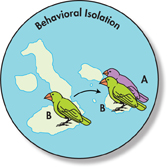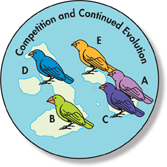Behavioral Isolation Now, imagine that a few birds from the second island cross back to the first island. Will population-A birds breed with population-B birds? Probably not. These finches choose mates carefully. During courtship, they closely inspect a potential partner's beak. Finches prefer to mate with birds that have the same-size beak as they do. Big-beaked birds prefer to mate with other big-beaked birds, and smaller-beaked birds prefer to mate with other smaller-beaked birds. Because the populations on the two islands have evolved differently sized beaks, they would probably not mate with each other.
Thus, differences in beak size, combined with mating behavior, could lead to reproductive isolation. The gene pools of the two bird populations remain isolated—even when individuals live in the same place. The populations have now become two distinct species.
Competition and Continued Evolution As these two new species live together on the first island, they compete for seeds. During the dry season, birds that are most different from each other have the highest fitness. That is because the more specialized birds have less competition for certain kinds of seeds and other foods. Over time, species evolve in a way that increases the differences between them. The species-B birds on the first island may evolve into a new species, C.
The combined processes of geographic isolation on different islands, genetic change, and behavioral isolation could have repeated itself again and again across the Galápagos chain. Over many generations, the process could have produced the 13 different finch species found there today.
 In Your Notebook Explain how natural selection and behavioral isolation may have lead to reproductive isolation in Darwin's finches.
In Your Notebook Explain how natural selection and behavioral isolation may have lead to reproductive isolation in Darwin's finches.
17.3 Assessment

-
Review What is geographic isolation?
Predict A newly formed lake divides a population of a beetle species into two groups. What other factors besides isolation might lead to the two groups becoming separate species?
-
Review What types of reproductive isolation may have been important in Galápagos finch speciation? Explain.
Apply Concepts Explain how the vegetarian tree finch, which feeds on fruit, might have evolved.
`
BUILD VOCABULARY
Temporal comes from the Latin word tempus, meaning “time.” How is time a factor in temporal isolation?
Isolation is related to the Latin word insula, meaning “island.” After reading about isolating mechanisms in this lesson, does the common origin of these two words make sense? Explain your answer.

Table of Contents
- Formulas and Equations
- Applying Formulas and Equations
- Mean, Median, and Mode
- Estimation
- Using Measurements in Calculations
- Effects of Measurement Errors
- Accuracy
- Precision
- Comparing Accuracy and Precision
- Significant Figures
- Calculating With Significant Figures
- Scientific Notation
- Calculating With Scientific Notation
- Dimensional Analysis
- Applying Dimensional Analysis






